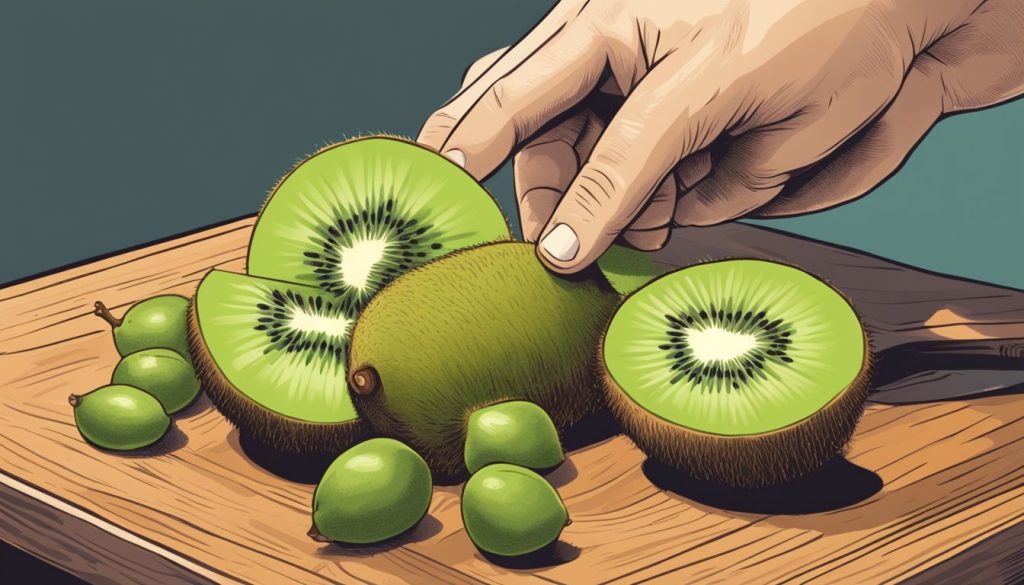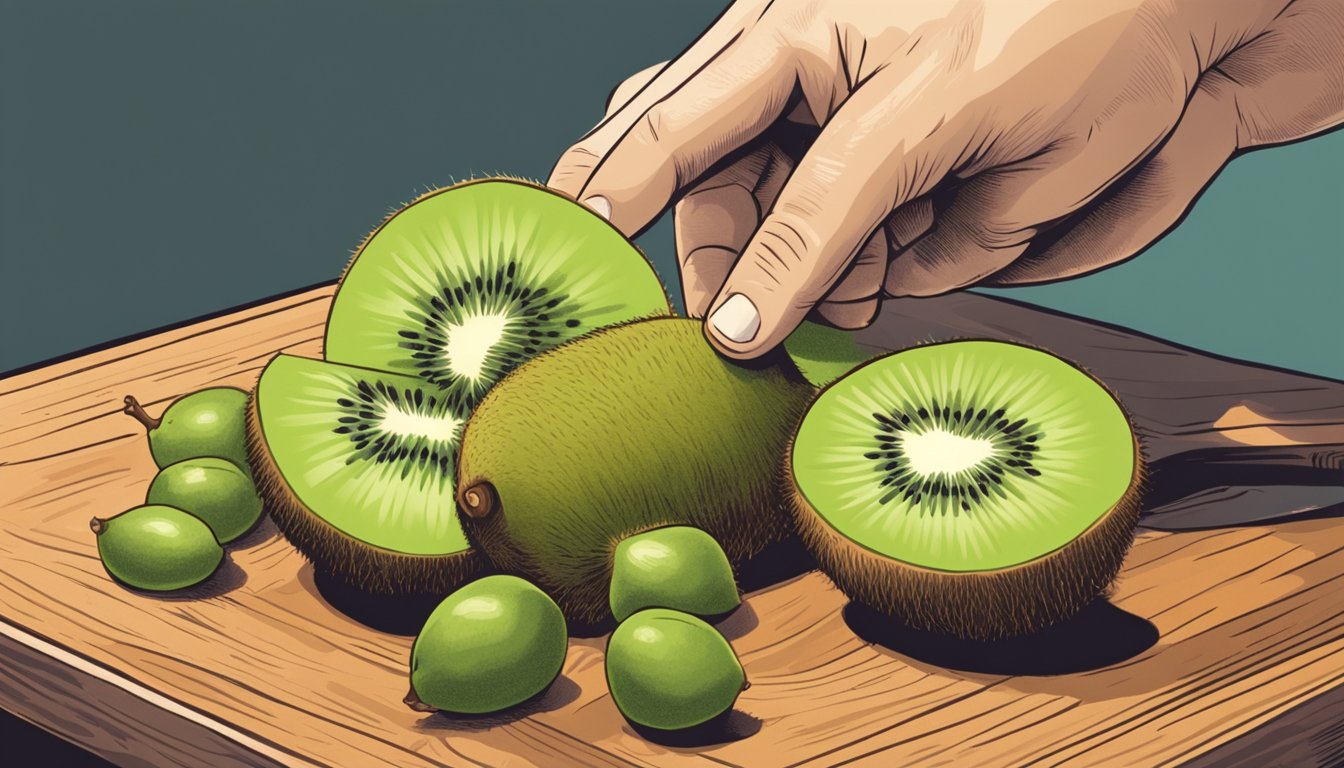Kiwifruit, with its fuzzy brown exterior and vibrant green flesh, is a delicious and nutritious treat. Knowing how to select a perfectly ripe kiwi
Understanding Kiwifruit
Kiwifruit, a unique berry with distinctive flavors and textures, undergoes specific changes as it ripens. Its development from unripe to ripe affects taste, smell, and feel.
The Kiwi Profile
Kiwifruit, also known as Chinese gooseberry, belongs to the berry family. It has a fuzzy brown exterior and vibrant green flesh studded with tiny black seeds. Kiwis offer a complex flavor profile, combining sweet, tart, and tangy notes.
When ripe, kiwis taste similar to a blend of strawberry, pineapple, and banana. The fruit’s texture is soft and juicy, with a slight crunch from the seeds. Unripe kiwis have a firmer texture and a more acidic, vegetal taste.
Nutritionally, kiwis are rich in vitamin C, fiber, and antioxidants. They can be eaten fresh, added to salads, or used in smoothies.
The Ripening Process
Kiwifruit continues to ripen after harvesting. This process involves several changes in the fruit’s composition and characteristics.
As kiwis ripen, their flesh softens and becomes more tender. The fruit’s sugar content increases, developing a sweeter taste and more intense aroma. The acidity levels decrease, balancing out the flavor profile.
Unripe kiwis are firm to the touch and have a tart, astringent taste. Ripe kiwis yield slightly when gently squeezed and offer the ideal balance of sweetness and acidity. Overripe kiwis become very soft and may develop an overly sweet or fermented flavor.
Ethylene Gas and Ripening
Ethylene gas plays a crucial role in the ripening of kiwifruit. This naturally occurring plant hormone triggers the ripening process in many fruits, including kiwis.
Kiwifruit produces ethylene as it ripens, but at lower levels compared to other fruits. Exposure to external ethylene can speed up the ripening process. This is why placing kiwis in a paper bag with other ethylene-producing fruits like apples or bananas can accelerate ripening.
Temperature also affects ethylene production and sensitivity. Warmer temperatures increase ethylene production, speeding up ripening. Cooler temperatures slow down this process, allowing for longer storage of unripe kiwis.
Assessing Kiwi Ripeness
Determining kiwifruit ripeness involves using multiple senses. Visual inspection, touch, and smell provide key indicators of a kiwi’s readiness for consumption.
Visual Cues
The appearance of a kiwifruit offers valuable insights into its ripeness. Green kiwis should have a brown, fuzzy exterior when ripe. Look for a uniform color without any patches of green. The skin may develop small wrinkles as it ripens further. Avoid fruits with visible bruises, mold, or soft spots.
Golden kiwis turn from green to golden-yellow when ripe. Their skin becomes smoother and less fuzzy than green varieties. Check for an even coloration across the fruit’s surface.
Tactile Examination
Gently squeezing the kiwi provides crucial information about its ripeness. A ripe kiwi yields slightly to gentle pressure but still maintains some firmness. It should feel plump and full.
If the fruit feels hard, it needs more time to ripen. Conversely, if it’s too soft or mushy, it may be overripe. Avoid kiwis with excessive give or noticeable dents.
For optimal ripening, place unripe kiwis in a paper bag with an apple or banana. These fruits release ethylene gas, which speeds up the ripening process.
Olfactory Indicators
A ripe kiwifruit emits a subtle, sweet aroma. Hold the fruit close to your nose and inhale. A fragrant scent indicates ripeness and readiness for consumption.
Unripe kiwis have little to no smell. If you detect a strong, fermented odor, the fruit may be overripe or starting to spoil.
Remember that the intensity of the aroma can vary between kiwi varieties. Some may have a more pronounced scent than others when ripe.
Ripening Kiwifruit at Home
Kiwifruit can easily be ripened at home using simple techniques. Natural methods allow the fruit to ripen gradually, while accelerated approaches speed up the process for quicker enjoyment.
Natural Ripening Techniques
To ripen kiwifruit naturally, place them in a bowl on the countertop at room temperature. This method typically takes 3-5 days.
For best results, choose kiwis that are firm and free of blemishes. The fruit will soften and become sweeter as it ripens.
Check ripeness by gently pressing the skin. A ripe kiwi will yield slightly to pressure.
Avoid storing unripe kiwifruit in the refrigerator, as cold temperatures halt the ripening process.
Accelerating the Ripening
To ripen kiwifruit faster, place them in a paper bag with other ethylene-producing fruits like apples or bananas. The paper bag traps ethylene gas, speeding up ripening.
Avoid plastic bags, which can trap moisture and lead to mold growth.
For very quick ripening, wrap kiwis in a paper towel and microwave in short 15-second bursts. Check frequently to avoid overheating.
A ripe kiwi will have slightly wrinkled skin and a sweet aroma. The flesh should be soft and sweet when tasted.
Storing Kiwifruit

Proper storage techniques can extend the shelf life of kiwifruit and maintain its quality. Different methods are suitable for short-term and long-term storage needs.
Short-Term Storage Solutions
For immediate consumption, store ripe kiwifruit at room temperature for 3-5 days. Place them in a fruit bowl away from direct sunlight. To slow ripening, refrigerate kiwis in a plastic bag for up to 4 weeks. Ensure the bag has small holes for air circulation.
Keep unripe kiwis at room temperature to ripen naturally. To speed up ripening, place them in a paper bag with an apple or banana. The ethylene gas produced by these fruits will hasten the process.
Long-Term Storage Approaches
Freeze ripe kiwis for extended storage. Peel and slice the fruit, then arrange on a baking sheet. Freeze until solid, about 2 hours. Transfer to airtight containers or freezer bags. Frozen kiwis last up to 12 months.
For whole kiwis, blanch them in boiling water for 15 seconds, then plunge into ice water. Pat dry, wrap individually in plastic wrap, and freeze. This method preserves texture better than freezing raw kiwis.
Canning is another option for long-term storage. Prepare a light syrup and process peeled, sliced kiwis in sterilized jars. Follow safe canning practices to ensure proper preservation.
Utilizing Kiwifruit in Recipes

Kiwifruit’s versatility shines in both sweet and savory dishes. Its unique flavor profile and nutritional benefits make it an excellent addition to various culinary creations.
Incorporating Kiwi into Meals
Ripe kiwis add a burst of flavor to smoothies, parfaits, and baked goods. For smoothies, blend peeled kiwi with yogurt, spinach, and banana for a nutrient-packed drink. In parfaits, layer diced kiwi with Greek yogurt and granola for a refreshing breakfast or snack.
Kiwi can also enhance savory dishes. Dice it into salsa for a tropical twist or use it in marinades for meat. Unripe kiwis work well in chutneys or relishes due to their firmer texture and tart flavor.
Overripe kiwis are perfect for baking. Mash them into muffin or cake batters for added moisture and natural sweetness.
Maximizing Nutritional Value
Kiwifruit is packed with vitamins C and K, fiber, and antioxidants. To retain these nutrients, consume kiwi raw when possible. If cooking, use low-heat methods to preserve its nutritional content.
Pair kiwi with iron-rich foods like spinach or lean meats. The vitamin C in kiwi enhances iron absorption, boosting its nutritional impact.
For a nutrient-dense snack, mix kiwi with other fruits high in different vitamins and minerals. This combination provides a wide range of health benefits in one serving.
